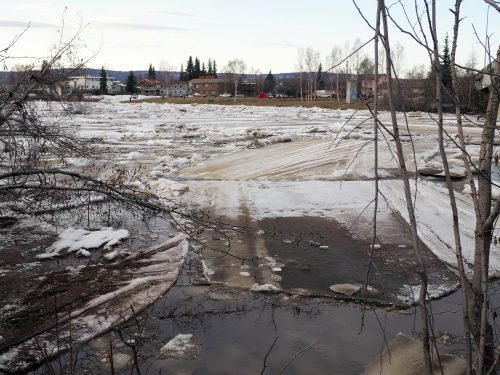Submit observations to improve river breakup forecasts
April 23, 2021
Heather McFarland
9074746286

Spring has arrived in Alaska, which means it is time to submit your observations of river ice breakup. Photos of changing ice conditions provide valuable information used by the National Weather Service in flood warnings and river breakup forecasts.
Since spring 2020, a University of Alaska Fairbanks citizen science project, Fresh Eyes on Ice, has partnered with the NWS to increase the number of river observations from people across Alaska.
People can submit photos of rivers, ponds, lakes and sloughs to fresheyesonice.org. Make sure to include the location and a short description of conditions. Observations can also be made over the phone by calling the National Weather Service, 1-800-847-1739.
“All the photos are extremely valuable,” said Katie Spellman, Fresh Eyes on Ice investigator from the UAF International Arctic Research Center. “are shared in real time with the National Weather Service Alaska Pacific River Forecast Center, and both help our river forecasters create the ice jam flood warnings and contribute to a long-term data set to understand ice break-up dynamics across Alaska.”
Beyond the immediate benefit to NWS forecasters, observations are also used by scientists at UAF to better understand ice dynamics and how they are changing. As Alaska warms, the number of fatalities from falling through ice is expected to increase. Understanding what causes dangerous ice situations like overflow and open water in winter can make traveling on ice safer.

“We are using the photos contributed through this effort alongside many other sources of historical data, like boating records and satellite imagery, to piece together how the timing and process of ice formation and decay is changing,” said Chris Arp, hydrologist from UAF Water and Environmental Research Center.
Fresh Eyes on Ice also works with community youth groups and citizen scientists to monitor ice thickness near Alaska communities. Currently 13 communities participate, from Noatak and Bethel in the west to Arctic Village in the northeast and Kenny Lake in the south. An additional 300-plus individuals share ice observations and information online. The contributors have an active Facebook group where people provide informal ice reports.
Recently, Fresh Eyes on Ice was awarded funding from NASA to expand the effort. Together with Tanana Chiefs Conference, NASA's GLOBE Observer, the National Weather Service Alaska-Pacific River Forecast Center and Goldstream Group Evaluation, the research team will receive $293,362. After 18 months, they will be able to compete for an additional $1.2 million.
The expanded effort will enable the team to develop a user-friendly phone app that aligns with the data needs and interests of Alaska river communities.
ADDITIONAL CONTACTS: Katie Spellman, 907-388-5178, klspellman@alaska.edu; Chris Arp, 907-223-8839, cdarp@alaska.edu


